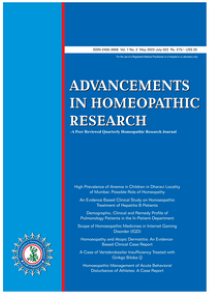
Publisher: Anuj Arora
Print ISSN: 2456-3668
Online ISSN: 2583-5661
Number of issues per year: 4
Frequency: Quaterly
Review Process: Peer Reviewed Refereed Journal
Month(s) of publication: Feb, May, Aug and Nov
Coverage: 2016
Advancements in Homeopathic Research journal expect the highest ethical standards from their authors, reviewers and editors when conducting research, submitting papers and throughout the peer-review process. Scientific misconduct and violation of publishing ethics can take different forms, and be committed with or without intent. Examples of misconduct and breaches include:
COMPLIANCE WITH ETHICAL STANDARDS
The authors need to ensure that the principles of ethical and professional conduct have been followed, it is required to include the information regarding sources of funding, potential conflicts of interest (financial or non-financial), informed consent if the research involved human participants, and a statement on welfare of animals if the research involved animals.
If applicable, authors need to include the following statements:
The Editors reserve the right to reject manuscripts that do not abide by the above-mentioned guidelines and the author will be solely responsible for false statements.
Examples Of Disclosures:
Funding: This study was funded by (funding agency) (grant number) or the work was supported by (funding agency) (grant number)
Conflict of Interest: The research is sponsored by X and author A has received a grant from company Y.
If no conflict exists, the authors should state: “Conflict of Interest: The authors declare that they have no conflict of interest.”
Anti Plagiarism Policy
“Advancements in Homeopathic Research” strongly discourages plagiarism ,duplication/reduplication of data already published in other journals (even when certain cosmetic changes/additions are made).Any such paper/article would be summarily rejected as per UGC Guideline.
Peer Review
All submitted articles will be initially subjected to editorial procedures, if found suitable for publishing will be sent to reviewers for peer review. Once the article will be found suitable to publish by reviewers, authors will be intimated for acceptance over mail with the galley proof which the author is insisted to reply within a week, after which the article will be sent for publishing.
All papers submitted are subject to Peer Review process. All accepted papers will be suitably edited before publication.
Narrative review articles written by scientist(s)/ expert(s) working in the particular area and who has/have published quality original research, will be considered. The article could be about 15-20 typed pages with not more than 100 references (recent & relevant) and an abstract of about 250 words. Tables and Figures could be included as per requirement. Copyright permission should be obtained from the copyright holder in advance if a published Table/Figure is included.
The articles under this section will be critical appraisal of different studies on important topics of clinical/public health significance to obtain an unbiased quantitative estimate of the overall effect of an intervention or variable for a defined outcome. The focus could be on cause, diagnosis, prognosis, therapy, prevention, etc. These would be thoroughly researched articles giving comprehensive and balanced perspective. There should be a structured abstract. Systematic reviews could be about 2500-3000 words with minimum number of Tables/Figures. These will be published subject to peer review.
These are primarily opinion pieces written by senior scientists, public health experts and policy makers. Such papers will be generally written by a single author. No anonymous articles will be published. These should be about 1000-1500 words and may contain references. Except for commissioned pieces, all submissions will be published subject to peer review.
Original research manuscripts containing well defined study design and sample size but limited parameters analysed may be submitted as Short Papers. These would be about 2000 words and contain a structured abstract with a combined Results & Discussion section. A research correspondence would be either a preliminary/pilot study or a post-implicative report with no abstract. Submissions with preliminary investigative data with limited methodology and sample size but having important clinical implications may be submitted as a Short Note containing a 200 words unstructured abstract. Both Correspondence and Short Note would be of around 1000-1500 words containing either a Table and/or a Figure.
Rare and educative cases may be presented under this section. A concise write up of around 125-150 words may be submitted, containing details of the place (department/institute) and period (month/year) of patient presentation, diagnosis, treatment and follow up (along with the duration of follow up). Clear and well resolved images (up to 3-4 or as panels; JPEG/TIFF format with at least 300 dpi resolution) and up to two videos not exceeding 1MB may be submitted with the write up.

Publisher: Anuj Arora
Print ISSN: 2456-3668
Online ISSN: 2583-5661
Number of issues per year: 4
Frequency: Quaterly
Review Process: Peer Reviewed Refereed Journal
Month(s) of publication: Feb, May, Aug and Nov
Coverage: 2016
Login to access subscriber-only resources.
Copyright ©2021: - All Rights Reserved.
Email - support@acspublisher.com
Customer Support - 08459080899